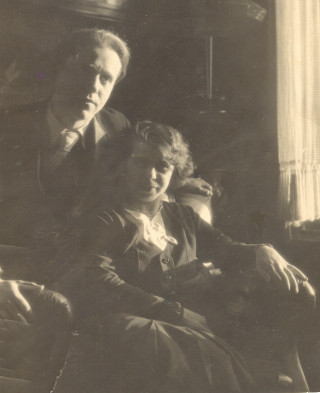
Two Soulmates: Karl Drerup and Lisbeth Steffens© Eva Masthoff |
|
Karl Drerup, born in Borghorst, Germany, grew up in Münster and died at the age of 96 in a nursing home in Massachusetts.
„His technical virtuosity, immense powers of imagination, broad education, personal magnetism and wit were irresistable.
In a broader sense, he represents a view of the thriving art world of Germany in the 1920s and 1930s that existed outside the Bauhaus
and which is still little-known or or studied“, says Jane Port, an expert on American Decorative Arts and on Karl Derup.
On August 26, 2010, he would have celebrated his 106th birthday, Karl the allround talent: printmaker, and illustrator, painter, ceramic artist and American Master of Enamels. To mark his birthday, the Karl Drerup Art Gallery at Plymouth State University, New Hampshire, shows his graphic oeuvre. The States have been his adopted country since 1937. „The exhibition is a most appropriate showcase of his early life“, says his son Oliver who lives in Canada. „A Modernist Drawn to Life“, opened on August 14th, 2010, focuses on his innate talent as a draftsman which laid the foundation for all his future work. „Drawings are always the most personal and intimate aspect of a graphic artist’s life and show the evolution of the individual with the greatest clarity. Most poignantly if taken from sufficiently early examples, they show how the whole story began.“ The show of his drawings and graphic art is backed up by the rich iconography of his paintings and the consummate craftsmanship evident in his magnificent enamels. When I told Oliver Drerup about my plans to write a portrait about his father, he warmly welcomed the idea. „The cultural memory of Karl Drerup would profit from a variety of observers particularly when your contribution is so tempered by your love and understanding fort the countryside in which he grew his first roots“, he wrote. 90 year-old Friedel Drerup happened to know Karl during his early years. „At that time I had just started school which explains why Karl preferred chatting to his elder cousin Anneliese at his uncle Bernhard’s (nickname „Öhm“) home at Greven. Anneliese shared his love of animals. Although she later moved to Berlin they kept in touch by letter throughout their lives. Luckily Marlene Böringer has many old photographs showing Karl and Lisbeth. The two cousins had a passion for what Karl’s stepfather Arnold Falter used to call „breadless art“. Marlene Böringer recalls her aunt Lisbeth telling her that Arnold Falter insisted on Karl serving an apprenticeship with a decorator before allowing him to attend art school (Werkkunstschule Münster). Lisbeth’s father made her work in the office of his brewery where she learnt about book keeping and running a business. Only after serving her apprenticeship with a dressmaker she was allowed to pursue a career in fashion design. Elisabeth Antonie (Lisbeth) was born at Euskirchen on June 13, 1900. Eugen Aloys, her father, was a wealthy businessman and entrepreneur who owned both the Steffens Brewery and the big „Hotel zur Post“ as well as several other properties locally. Her mother who originated from Neuwied/Rhine also came from a comfortable family background. The couple had six children who were mainly brought up by nannies. The children had their meals, which differed from the food served to their parents, while sitting at a separate table. In those days, posture was an important part of table etiquette. Often they had to clutch books under their arm pits to help them to sit up straight. If one of the children happened to get up to announce it was his or her birthday, their father used to reply: „Very well, now sit down again.“ „It is a minor miracle that Lisbeth did not crack up under the unnecessarily strict and seemingly heartless upbringing. She was a very strong character.“ Many anecdotes revolve around her early years. Instead of his prayer book her cousin Karl preferred carrying a sketchbook under his arm while he attended the strict Cistercian monastery school at Hachenburg/Westerwald (Marienstatt Abbey). Lisbeth used to hide images of handsome nude males, a regular image in the sculptural iconography of Classical Antiquity, among her personal belongings. „As nothing is hiddden before the eyes of God and the eyes of the nuns, her delicious little secret was soon uncovered“, Marlene Böringer says. „Despite the uproar that followed my aunt never stopped having an eye for handsome men.“ |
| 1928: Karl and his cousin Lisbeth at her parents home at Euskirchen. The arm chair was moved to a farm during the bombing of Euskirchen. It survived and is the pride and joy of her niece Marlene Böringer. |

|
|
Oliver Drerup recalls that on many occasions his father spoke fondly of his visits to the Steffens Brewery of his grandfather Franz Wilhelm, founder of the Brewery at St. Severinsberg/Linz on the River Rhine. Karl loved watching the enormous draft horses which were used to power the beer waggons. He kept on drawing, painting and etching those horses for many years. It was at Euskirchen that the two cousins met. Either in 1918 or 1919 Lisbeth left the private grammar school for girls of the Dominican nuns at Euskirchen. For a short while she worked for Gerson’s, Berlin. The store which opened 1835 was the first of its kind and soon became fierce competition for traditional tailors and dressmakers. During the week she used to live on a shoestring but come Sunday, she used to while away the hours sitting at the legendary Hotel Kempinski, watching elegantly dressed women and stealing inspiration with her eyes. While it was the grandparents of famous fashion designer Christian Lacroix who first inspired him by placing a lot of importance on style and elegance, it was Lisbeth’s stylish mother who instilled in her an esthetic sensitivity. When visiting the famous health resort Wiesbaden, her mother’s nickname was „The Lady in black Taffeta“. |
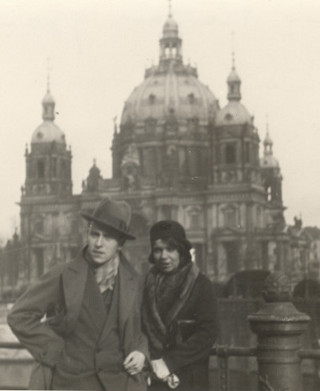
| 1930: Karl and Lisbeth in Berlin where in 1927 he enrolled in the Vereinigte Staatsschulen für Freie und Angewandte Kunst to study art at the graduate level under Hans Meid and Karl Michel. He was financially supported by his paternal uncle Bernhard. |
|
Lisbeth was a wayward young woman whose beauty was reminiscent of Mascha Kaléko (born June 7, 1907), the poetess, also born under the sign of Gemini. In the 1920s Lisbeth studied at the Kölner Werkschule (The Cologne Crafts School) commuting every day. The night before, she would place freshly made coffee in the fridge. In the morning while listening to cheerful music on the radio she used to drink it ice-cold and black. On March 26th, 1929, Professor Richard Riemerschmid appointed her master class student of the Kölner Werkschulen. She was known for her light hand and nimble fingers. |
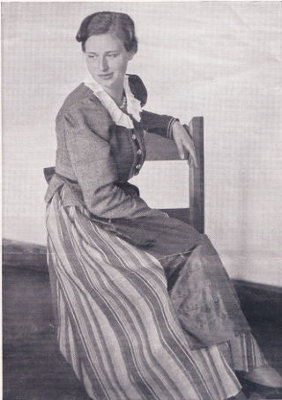
|
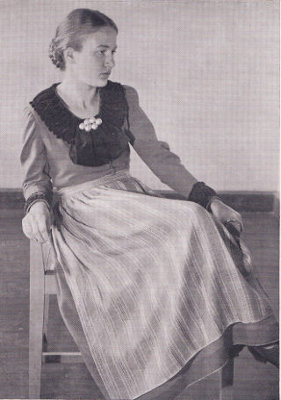
| Fashion designs by Lisbeths Steffens during her work as a lecturer of the Brunswick Crafts School in the 1930s |
|
|
Marlene Böringer, great-niece of Karl’s mother Elisabeth (née Steffens), remembers Lisbeth well. „She was small, black-haired, capricious and always „très chic“. She was full of life and had a lot of discipline. She expressed her views clearly, using only short sentences. Lisbeth loved wearing makeup which is why she was the envy of her students. So Lisbeth did her best to teach those stout young Braunschweig „maidens“ the art of makeup application. When there was not enough makeup available she used to resort to her box of watercolours. She also knew how to ward off nasty remarks made by colleagues who sympathized with the regime. Having been well prepared by her strict upbringing and being blessed with the gift of the gab which is typical of people of the Rhineland, she quipped: „If you have butter on your head you should not go out in the sun.“ For many years she was Head of the Dressmaking and Fashion Department of the „Handwerker- und Kunstgewerbeschule Braunschweig. “It goes without saying that she preferred designing Haute Couture to ordinary dressmaking,“ Marlene Böringer says. |
| Fashion designs by Lisbeth Steffens in the 1930s. |
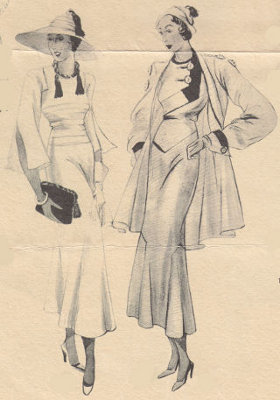
|
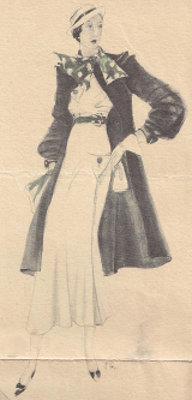
|
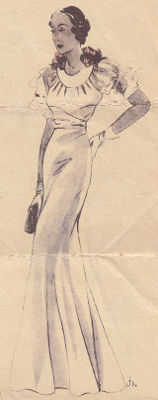
|
| Lisbeth had visited Karl when he was studying art in Florence. This is where his first ceramic works, animal sculptures, tiles and paintings were created. Many, many photographs tell of the time when she visited her cousin in Spain. They tell of days of pure and carefree bliss. Marlene Böringer: „The highly sensitive young artist and his creative cousin Lisbeth were a rich source of inspiration to each other.“ Lisbeth’s creativity focused on fashion. Her dresses and snazzy hats, the smart accessoires, leather hand-bags, and fringe shoes show that she was not only a gifted fashion designer but also a dab hand at sewing. Two presents given to her by her cousin Karl survived: a pair of castagnettes and the dramatic black felt sombrero from the famous Sombrereria Maquedano (founded 1908) in the Calle Sierpes in Seville. |
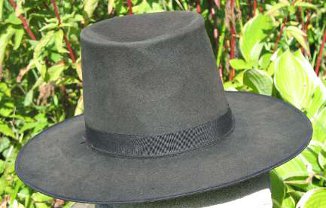
|
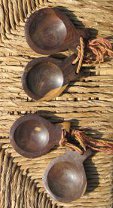
|
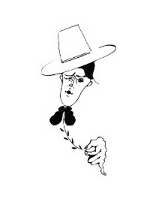
|
A sombrero made of black felt and a pair of castagnettes, Karl’s present for Lisbeth.
Is Karl wearing this sombrero on his self-portrait, pen and ink drawing, Malaga, November 1924? |
| In 1932, Karl was introduced in Florence to Gertrud Lifmann, the love of his life. Five years later the couple emigrated to the States. As for Lisbeth, she was married to architect Wilhelm Wolf by her uncle, the Reverend Franz Steffens, at Euskirchen on 23rd April, 1935. Even on her wedding day, she rocked the boat. Instead of wearing the traditional white wedding gown, she opted for a black one with a white veil and announced she had no intention of sitting on the sofa and graciously accepting congratulations and good wishes. Wilhelm and Lisbeth had a very happy marriage. She was an avid reader, loved to cook and had a keen eye for beauty. Her vitality, her zest for life did not fade until her husband’s death in 1963. Her husband had worked for a while for Gebrüder Taut in Berlin. Later he was appointed Head of the Construction Department at the College at Braunschweig (Städtische Handwerker- und Kunstgewerbeschule, Braunschweig) where Lisbeth was teaching. From 1st October, 1938, until November 17, 1945, he was Director of the School of German Master Craftsmen Hannover (Meisterschule des deutschen Handwerks, Hannover). Later he was made Government Building Surveryor at Nienburg (Staatsbauschule, Nienburg), Department Architecture and Civil Engineering. After retiring in 1957, the couple moved back to his first roots, Mainz. |
| Wilhelm Wolf in Braunschweig, 1931 |
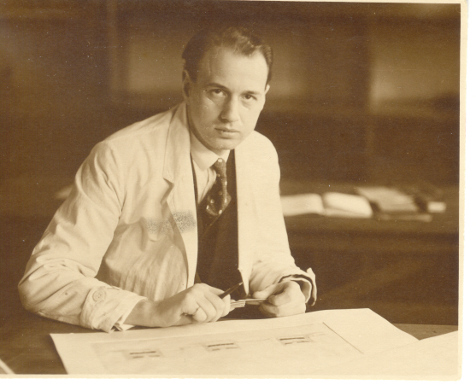
|
|
Lisbeth, devastated by the death of her husband, found some comfort in her creativity.
She went back to painting with watercolours which she had taken up while living at Nienburg.
She continued to work in this medium when she went to live in Mainz, in the Black Forest and the Spessart.
Her niece Marlene remembers the furniture in her house. „It had been made at the Handwerkerschule Braunschweig. Lisbeth liked to surround herself with art: Karl’s paintings and drawings as well as woodcuts by Fritz Röhrs, paintings by Fritz Bürger-Mühlfeld and Kurt Mohr. She adored living with objects rich in esthetic design and beauty. |
|
Flower Still Life by Lisbeth Steffens. With a few exceptions neither Karl nor Lisbeth used to date their pictures |
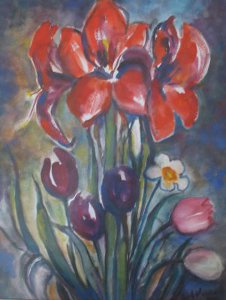
|

|
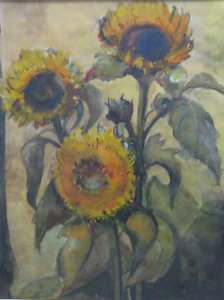
|
|
Lisbeth’s cousin Karl was not only an allround talent but also a linguist, fluent in Italian, Spanish and English. „Father was a gifted keyboard player and reconstructed complex classical pieces by ear“, his son Oliver recalls. Karl’s love of music was inherited from his mother Elisabeth and his aunt Josefine, a piano teacher. His mother used to gather her children around her while playing the piano. Christoph Götting, the son of Karl’s half-sister Maria Götting (née Falter) who lives in Hampshire also inherited the love of music from his grandmother Elisabeth Falter (née Steffens, widow of Ludwig Drerup). Christoph Götting is a violin maker held in high repute in the United Kingdom and further afield. „My mother, Maria Götting, although suffering from dementia, still recognizes Karl when she looks at his photographs,“ says her daughter Theresia Hebenstreit. Both Theresia, her sister Elisabeth Wegmann and her brother Christoph Götting still vividly remember Karl. |
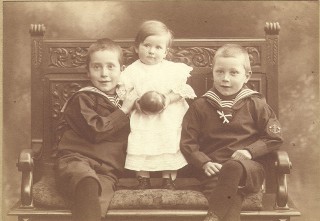
|
Maria Götting (née Falter) and her half-brothers Paul and Karl Drerup
|
|
Christian Böringer says: „Karl gave my great-aunt Lisbeth a whole host of drawings, etchings and paintings including many bullfighting scenes and illustrations: of Mérimée’s 'Carmen' as well as E.T.A. Hoffmann’s 'The Devil’s Elixier'. During the war and evacuation both my great-aunt and my mother somehow managed to keep those pictures in a safe place.“ Lisbeth lived with Karl’s pictures right up to October 2, 1980, the day she died as a result of a stroke. She never forgot her cousin Karl whom she greatly admired. Being artists, they were on the same wavelength and got on famously. The last time Karl and Lisbeth met was at a family gathering at Wiesbaden in 1962 when Karl visited his half-sister Maria Götting (neé Falter) during his tour of Germany in 1962. At the famous Café Blum, opposite the 'Kurhaus', Karl and Lisbeth were able to chat about old times. „The boundless widening of his heart“ which he refers to on the postcard, sent from Malaga to his family at Münster continued to echo in his paintings, etchings and lithographs, illustrations and drawings. Impressions of Florence, Malaga, Granada, Segovia, Ronda and Seville were also captured in numerous photographs taken along the way. |
| Back to Main Page |